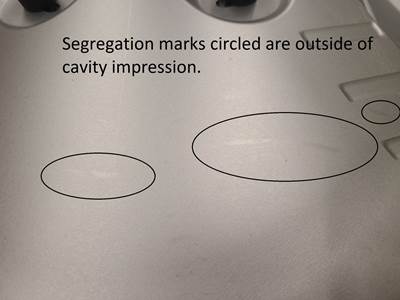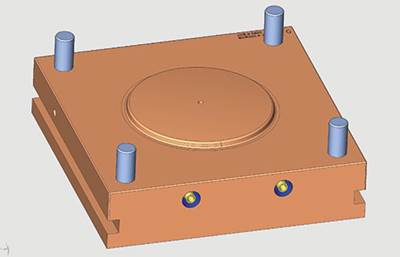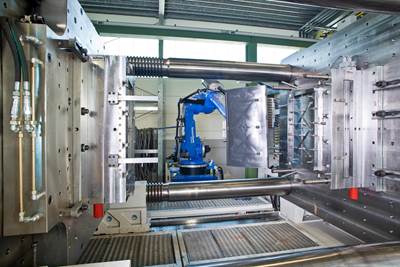ESSENTIAL READING
VIEW ALLHow to Achieve the Best Mold Finish
A look at factors that impact the polishability of tool steels and recommendations for obtaining a high-gloss finish.
Read MoreHow to Lower Cycle Times With the Right Tool Steel
Combining excellent mechanical properties, high wear resistance and high thermal conductivity in a specialty tool steel yields cycle time reduction.
Read MoreLaser Welding Versus Micro Welding
The latest battle in finely detailed restoration/repair of mold materials.
Read MoreHow to Eliminate Streaks and Weld Problems with Laser Technology
Laser technology overcomes streaking and welding challenges for new mold textures and texture repair.
Read MoreConsiderations for Mold Base Material Selection
Choosing the right material can greatly affect the profitability and cost of your application.
Read MoreLet’s Be Clear About Aluminum
Within the injection molding industry, a negative perception of aluminum for anything but prototype plastic parts persists, despite aluminum tooling being able to produce and run almost any resin that steel can, as well as produce millions of shots with unfilled resin with uniform results.
Read MoreLatest Mold Materials News And Updates
EDM Graphite Enables Moldmakers to Meet Strict Precision Requirements
Entegris Poco Materials highlights its EDM-3 graphite, known for exceptional strength, wear resistance and fine surface finish characteristics and thus an ideal solution for moldmakers’ most demanding applications.
Read MoreEDM Graphite Line for High-End EDM Machining
IMTS 2024: Mersen offers its complete family of EDM graphite, including its ultra-fine DS4 graphite. The graphite is used as the electrode which acts as a “cutting tool” in the sinker EDM, a machining process often used by moldmakers.
Read MoreTool Steel Offers Advantages For Production Efficiency, Component Service Life
Swiss Steel USA’s E 40 K Superclean offers benefits for a more efficient manufacturing processes in terms of production efficiency and component service life.
Read MoreImpact of Bio-Based and Recycled Resins on Molds
Recycled and biodegradable resins require tooling considerations for varying material properties, temperatures and consistent product quality.
Read MoreMold Steel Engineered for Better Mold Performance, Reduced Maintenance Costs
Edro Specialty Steel says its RoyAlloy material offers a comprehensive solution for mold base steels, delivering enhanced performance and long-term benefits over traditional materials.
Read MoreHigh-Density Graphite Material Engineered for Precision Spline Machining
Eastec 2025: MWI’s EC-15 high-performance graphite is a high-density material known for its excellent properties, making it well suited for manufacturing components that require high precision and reliability.
Read MoreFeatured Posts
How to Expand the Use of Aluminum Injection Molds
Six factors to consider to broaden the application of aluminum molds.
Read MorePTXPO 2025: Innovations, Impressions and Inspirations
As MMT’s Associate Editor, I had the opportunity to walk the show floor as well as work in the MMT booth, and I’m excited to share my insights on the technology trends that caught my attention — both new and established within the industry.
Read MorePTXPO 2025 Profile Preview Part 3 of 4: Check Out the Latest Technology for Moldmakers
Discover some of the latest moldmaking technologies awaiting you at PTXPO 2025. Here are some quick snapshots of the moldmaking solutions, products, technologies and services you’ll see at the show which can help you grow your business.
Read More3D Printing Accelerates R&D Process For Prototyping Molds
Utilizing Axtra3D’s additive technology, LSI Solutions, a medical equipment manufacturer found the compatible machine it needed to accelerate its R&D process for prototyping molds for medical devices.
Read MoreThe Benefits of Alloying Tool Steel
Improve tooling efficiencies, extend mold life and reduce overall tooling costs with a focus on tool steel properties that solve wear, flaking and cracking issues.
Read MoreOnline Tool Improves Mold Base Procurement Process
Mold base configurator streamlines D&M Tool’s ordering process with speed and accuracy, enhancing efficiency, reducing costs and minimizing errors through quick, accurate and user-friendly mold base ordering.
Read MoreFAQ: Mold Materials
What are the benefits of alloying tool steel?
Steels with a chromium content of at least 12% are generally considered corrosion-resistant. Martensitic tool steels have a high chromium content of 16% and a carbon content between 0.33%-0.38% that provides quenching and tempering during which only tempering carbides appear in the microstructure, leaving behind enough chromium to ensure corrosion resistance.
The resistance to corrosion is based on the formation of surface layers, protecting the metal from further reaction with oxygen. The most effective element is chromium. In combination with oxygen, it forms an oxide layer (chemical configuration: Cr2O3) on the surface, which shows a dense and amorphous structure as the chromium content increases. The formation of this Cr2O3 surface layer of approximately one nanometer promotes passivation, a process that protects the material against surface corrosion and ensures the functionality of the mold.
Alloying with molybdenum improves resistance to pitting corrosion, as it contributes to stabilizing the passivating Cr2O3 layer. In addition, molybdenum builds into the structure of the layer and strengthens it by preventing the removal of oxygen from the respective layer. Using stainless steels alloyed with molybdenum can also avoid corrosive attacks during mold cleaning, preventing hazardous products from entering the production process.
(Source: The Benefits of Alloying Tool Steel)
How can moldmakers optimize the quality of recycled plastic for molds?
The successful use of recycled materials in injection molding depends on how the original parts are recycled and re-pelletized. The two most important factors for producing a quality pellet of recycled plastic with consistent material properties are:
- Re-melting. Proper re-melting of the recycled material occurs under very low shear rates in the extruder and at the lower end of the melt temperature. The objective is to gently re-melt the original material, which ensures maintenance of the material properties.
- Melt filtration. The proper filtration process will remove any contaminants in the melt like cellulose, metal or wood pieces. State of the art melt filtration is fully automated and does not require manual operation steps. The melt is filtered continuously at low pressure and can remove particles as small as 70 microns in diameter.
Today’s recycling systems can help produce consistent quality plastic pellets that moldmakers can use in a wide variety of injection-molded parts.
(Source: Putting Recycled Plastics to Work)































